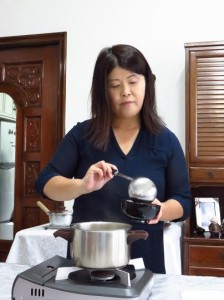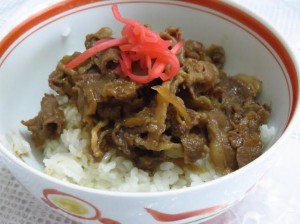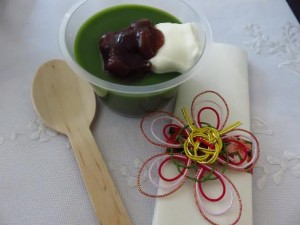 Salt, sweet, sour, bitter. I am assuming we have known about these four taste categories since Sesame Street was a dirt track through the woods. Each one tells our taste buds about what we are putting in our mouths, and whether it is safe to eat. For example, a sour taste, or acidity can alert the brain that the fruit is not ripe, or the milk off, and may upset our stomach – or, alternatively that it is our favourite citrus-based lolly. Sweetness identifies energy-rich – and potentially fattening – foods. Bitterness may warn us of something poisonous, something addictive, like coffee, or something we love like arugula. Salt says… more beer with your fish and chips?
Salt, sweet, sour, bitter. I am assuming we have known about these four taste categories since Sesame Street was a dirt track through the woods. Each one tells our taste buds about what we are putting in our mouths, and whether it is safe to eat. For example, a sour taste, or acidity can alert the brain that the fruit is not ripe, or the milk off, and may upset our stomach – or, alternatively that it is our favourite citrus-based lolly. Sweetness identifies energy-rich – and potentially fattening – foods. Bitterness may warn us of something poisonous, something addictive, like coffee, or something we love like arugula. Salt says… more beer with your fish and chips?
And then the Japanese invented umami. Which is what, exactly? It seems umami is difficult to translate. savoury? Tasty? Delicious? What it adds to our meals defies an easy descriptor. In technical terms it introduces our taste buds to glutamates, inosinates and guanylates. Simply, these three ingredients in our food combine to create that element of mouthwatering flavour lacking in, say, tapioca or rice. Umami enhances other flavours, making our food tastier and indicating protein-rich foods. Remarkably – as I discovered recently in Japan without understanding the significance – it also makes a little go a long way, by giving you a sense of being full much quicker.
A Japanese chemist first pinpointed and name the fifth taste in 1908, having discovered it in the depths of a bowl of seaweed soup (kombu dashi). Kombu dashi is an exceedingly simple broth made from kombu (seaweed) and katsuobushi (dried bonito, a smaller cousin to the tuna). Kombu has the highest glutamate score in the world. Katsuobushi is one of the wealthiest source of isonates. Together they packs a real punch on the umami scale. One to ten? Eleven.
Despite its undeniable x factor, scientists would debate its existence for decades, but finally, in 1985, the term umami was formally recognized, and the culinary world has followed hot on its heels. Although perhaps the chefs had recognized it all along, as that magical, nameless element that added the oomph to a watery soup, a mundane bowl of pasta or an insipid stew. Umami is what adds mouth-watering words like piquant, pungent, spicy, scrumptious, luscious, sumptuous, appetizing, ambrosial, delectable and delicious to the menu, and drowns out the damning dullness of antonyms like banal, bland, boring, insipid, uninspiring, and pedestrian.
bowl of pasta or an insipid stew. Umami is what adds mouth-watering words like piquant, pungent, spicy, scrumptious, luscious, sumptuous, appetizing, ambrosial, delectable and delicious to the menu, and drowns out the damning dullness of antonyms like banal, bland, boring, insipid, uninspiring, and pedestrian.
And here the lecture ends, and the fun begins. Last week I met umami in the flesh when the Japanese Team from our club of trailing spouses turned on a show in Dasmarinas to introduce us wayward westerners to “Umami: the fifth taste of Japanese Cuisine.” Which is not to say I haven’t met it before, but we had never been formally introduced,
although I did bump into it unwittingly on several occasions in Japan recently.
While our chefs bustled about in the kitchen, brewing up the ‘ones I prepared earlier,’ we, the audience, admired a pair of kimonos, or rather yukata, the summer version, on display in the entrance hall. Several ladies were persuaded to model some other ones, and we all cooed at the results and the glorious fabrics. Quite a crowd had gathered by the time we finally squeezed into seats around the demonstration kitchen that had been set up in the dining room. The menu was simple and our teacher, Satomi Kondo, was efficient and informative – through her very able translator, Mio Ishida – providing us with half a dozen quick and easy meals. At the core of each meal was the umami rich dashi broth.
 Gyūdon means beef in a bowl. It is a popular Japanese dish of rice topped with onion and thinly sliced beef (sukiyaki style), simmered in dashi, and flavoured with soy sauce and mirin, that sticky, sweet rice wine. It is traditionally served with pickled ginger. Beef only wandered onto Japanese tables in the late nineteenth century, when the Emperor Meiji opened the long-sealed doors to the west, transforming a feudal society into a modern civilization, and adopting many western customs. Not being one for boiled meat, I was happily surprised by the sweet and savoury flavour of this dish.
Gyūdon means beef in a bowl. It is a popular Japanese dish of rice topped with onion and thinly sliced beef (sukiyaki style), simmered in dashi, and flavoured with soy sauce and mirin, that sticky, sweet rice wine. It is traditionally served with pickled ginger. Beef only wandered onto Japanese tables in the late nineteenth century, when the Emperor Meiji opened the long-sealed doors to the west, transforming a feudal society into a modern civilization, and adopting many western customs. Not being one for boiled meat, I was happily surprised by the sweet and savoury flavour of this dish.
We were then shown how to cook the rice in a traditional clay pot, or donabe, learning to rinse the rice three times using the heel of our hand to grind the starch from the rice. This allowed the rice to better absorb the water, and soften as it cooked. By the time the rice has been rinsed and soaked in water for 30 minutes, abracadabra it had swollen to a considerably greater volume than we started with. The process of then cooking it in the clay pot over a gas flame had me reaching for my electric rice cooker: bring to boil for 7 minutes; turn heat to medium for another 7 minutes; and finally cook for yet another 7 minutes on a low flame. Then remove from the heat and allow to sit for 5 minutes. I’m sure it would taste better than mine, but I’m not sure if I have the patience. I would probably wander off and boil the pot dry. Nonetheless it was a lovely process to watch – something like making an English pot of tea.
And we learned to make dashi from scratch with konbu seaweed – paper thin strips or sheets the colour of licorice –  and katsuobushi, or bonito flakes that soak in the stock like bay leaves. While the dried seaweed was rehydrating in a warm bath, we examined the katsuobushi, which looked like a lump of fossilized wood and felt surprisingly heavy in our hands. Smoked, fermented and dried, it is then shaved with a special tool: a katsuobushi kezuriki, like a carpenter’s plane, while the results appear identical to the curly wood shavings we would use to make beards on our collage portraits at school. Luckily they didn’t taste the same. The smoky, salty bonito curls almost melt on your tongue, and apparently make a moreish snack, as well as a vital seasoning for dashi. Laughing, most of the Japanese ladies admitted they usually resort to the ‘instant’ variety that comes in a stick, a bit like our chicken stock cubes.
and katsuobushi, or bonito flakes that soak in the stock like bay leaves. While the dried seaweed was rehydrating in a warm bath, we examined the katsuobushi, which looked like a lump of fossilized wood and felt surprisingly heavy in our hands. Smoked, fermented and dried, it is then shaved with a special tool: a katsuobushi kezuriki, like a carpenter’s plane, while the results appear identical to the curly wood shavings we would use to make beards on our collage portraits at school. Luckily they didn’t taste the same. The smoky, salty bonito curls almost melt on your tongue, and apparently make a moreish snack, as well as a vital seasoning for dashi. Laughing, most of the Japanese ladies admitted they usually resort to the ‘instant’ variety that comes in a stick, a bit like our chicken stock cubes.
Our instructor then followed up with sumashi and miso soups which both use dashi as a base stock, to which can be added a variety of ingredients such as tofu, spinach or shiitake mushrooms. Finally, the ubiquitous bonito broth was boiled with mirin and soy sauce to make a sauce to go with cold noodles or tempura.
The buffet lunch that followed was a splendid spread, which we loaded onto our black lacquered trays with glee. First, the gyudon put in an appearance, topped with red pickled ginger. I also collected a petit pot of Japanese pickled vegetables. Then there was a platter of crispy chicken karaage: bite sized pieces of chicken marinated in ginger, garlic and soy sauce, then coated in potato starch and fried – a sophisticated KFC. The tamagoyaki or rolled omlette was unexpectedly sweet and heavy on the tongue, but could be balanced by the green vegetables – okra and beans – marinated in a light sesame sauce, known as goma-ae in Japanese. A potato salad seemed strangely out of place at a Japanese lunch, but, adopted from America, the Japanese have made it their own, and I found it in many restaurants in Japan: chunky spuds with a sprinkle of ham and chives, and a much lighter, tangier mayonnaise than you will find in the west. A tiny container of green tea noodles and sauce looked like spaghetti in pesto, but had that unusual taste of tannin: slightly drying, slightly bitter. And of course, a melamine lidded bowl with miso soup, garnished with a fingernail-sized gluten flower.
 Dessert? Thick and almost savoury maccha pudding, like panacotta, flavoured with green tea, topped with a splash of sweet red bean paste and a dollop of whipped cream. Yum! Our hostesses finished off their performance with a short tea ceremony, giving us each a taster of both sencha and houjicha green teas Sencha, like most green teas, is simply infused in hot water. Houjicha is traditionally roasted in a porcelain pot over charcoal, which alters its colour from green to a reddish-brown and adds an appealing smoky layer to the tannin flavour.
Dessert? Thick and almost savoury maccha pudding, like panacotta, flavoured with green tea, topped with a splash of sweet red bean paste and a dollop of whipped cream. Yum! Our hostesses finished off their performance with a short tea ceremony, giving us each a taster of both sencha and houjicha green teas Sencha, like most green teas, is simply infused in hot water. Houjicha is traditionally roasted in a porcelain pot over charcoal, which alters its colour from green to a reddish-brown and adds an appealing smoky layer to the tannin flavour.
The grand finale was a performance by an extremely talented young man, Mr. Yu Miyoshi, who had come along in his lunch hour to introduce us to the traditional Japanese 13-stringed zither or Koto. A beautiful piece of highly polished striated kiri wood, it was topped with a complex fretwork of strings and bridges, which he plucked and swept skillfully with three fingers tipped with metal plectra. Having moved to Manila last year, Mr. Miyoshi uses his spare time to give recitals and introduce Japanese Koto music.
lunch hour to introduce us to the traditional Japanese 13-stringed zither or Koto. A beautiful piece of highly polished striated kiri wood, it was topped with a complex fretwork of strings and bridges, which he plucked and swept skillfully with three fingers tipped with metal plectra. Having moved to Manila last year, Mr. Miyoshi uses his spare time to give recitals and introduce Japanese Koto music.
If there is an instrument that illustrates a musical version of umami, this is it.
*With thanks to my good friend June Vann for her photographs. My new camera, you ask? The battery was flat. Of course.
